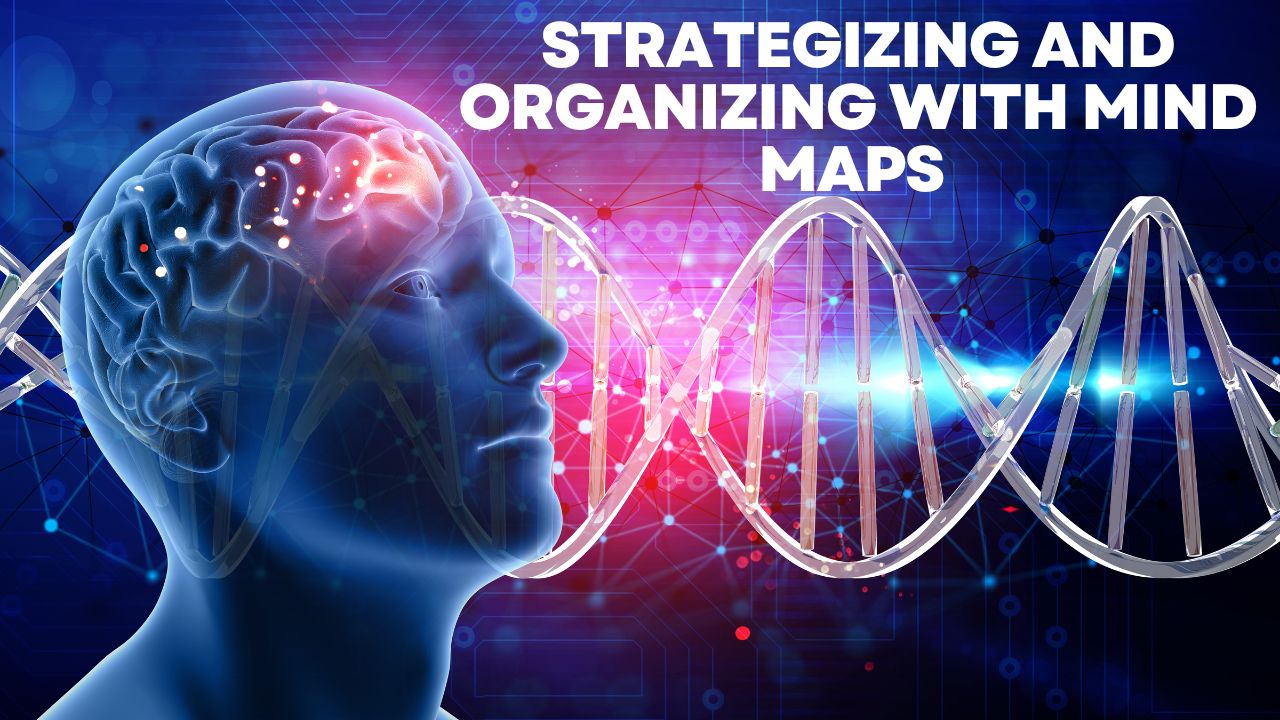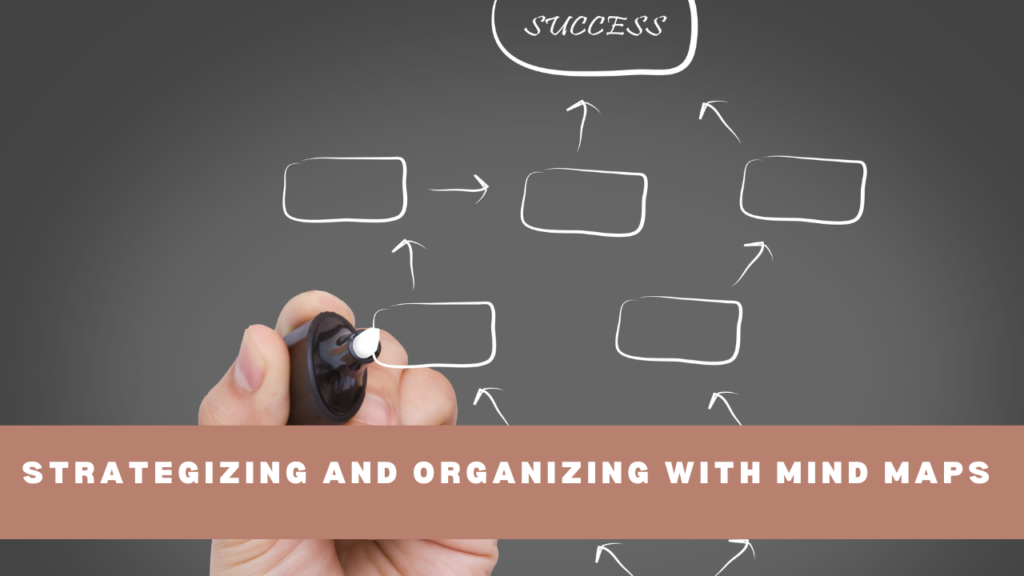Strategizing and Organizing with Mind Maps

“Creativity is intelligence having fun.” – Albert Einstein
The skill of efficient preparation and organization becomes crucial in a world full of ideas and information. Using mind maps is one age-old method that has been praised by imaginative minds for generations. It’s about releasing the intelligence within and having fun while doing it, as Albert Einstein suggests.
“Explore the dynamic world of strategizing and organizing with mind maps. Our guide, ‘Strategizing and Organizing with Mind Maps,’ offers insights into turning ideas into successful execution. Uncover the transformative power of mind maps in enhancing creativity, efficiency, and overall productivity.”
Table of Contents
ToggleThe Process of Using Mind Maps:
Ideation:
A mind map is essentially a visual depiction of ideas and thoughts. Tony Buzan, a British author and educational consultant who pioneered mind mapping, feels that mind mapping holds the secret to unleashing creativity. To create a web of connected ideas, start with a central concept or idea in the center and radiate outward with related topics and subtopics. Read more such articles on Vantage Vista Blog.
Seeing the Bigger Picture:
Mind maps give people a comprehensive perspective that enables them to see the larger picture. The brain’s capacity for pattern recognition was highlighted by Nobel laureate psychologist and author Roger Sperry. Mind maps take advantage of this and help with both thorough comprehension and memory of information.
Planning Projects:
Project Planning: Mind maps are flexible tools for project planning. Projects can be broken down into manageable parts so that people can see how each task relates to the overall objective. Author and productivity guru David Allen supports this approach, which increases project effectiveness.
Executing Ideas:
Bringing ideas from the drawing board to reality can be difficult. Mind maps provide an organized method for developing ideas, determining feasible steps, and monitoring advancement, which helps to expedite the process. Entrepreneur and best-selling author Tim Ferriss recommends this productivity method.
Working Together:
Mind maps encourage teamwork. In a virtual meeting or a team brainstorming session, participants can share ideas, visualize the group’s ideas, and build on each other’s insights. The teamwork component is consistent with the ideas of management guru Peter Drucker, who highlighted the importance of collaboration.
Internet Mapping:
Online mind mapping tools have completely changed the process in the digital age. People may easily create, edit, and share Mind Maps with platforms like MindMeister and XMind, which promotes accessibility and remote collaboration.
Strategizing and Organizing with Mind Maps - Uses of Mind Maps:
Under Which Scenarios Can Mind Maps Be Best Utilized?
Strategic Planning:
Companies like Apple have employed Mind Maps in strategic planning, outlining long-term goals and the steps needed to achieve them.
Content Creation:
Writers, including J.K. Rowling, have utilized Mind Maps to structure complex storylines and ensure narrative coherence.
Problem Solving:
Google, known for its innovative problem-solving approach, incorporates Mind Maps to brainstorm solutions and visualize strategies.
Learning and Revision:
Students benefit from Mind Maps for studying and revision. The simplicity of the method aids in information retention.
Business Processes:
Amazon employs Mind Maps for process optimization, breaking down intricate operations into manageable components.
Tools to Support Mind Maps:
MindMeister: A collaborative online tool, allowing real-time brainstorming and sharing.
Real-Life Example: Daimler AG (Germany)
Daimler, the multinational automotive corporation, utilizes MindMeister for collaborative brainstorming and project planning. Teams across different departments engage in real-time sessions, fostering innovative ideas for product development and process optimization.
XMind: Offers a user-friendly interface with advanced features, suitable for both beginners and experienced Mind Mappers.
Real-Life Example: Tata Consultancy Services (India)
Tata Consultancy Services (TCS), a global IT services company, incorporates XMind into its strategic planning and client collaboration processes. The user-friendly interface of XMind facilitates effective communication of complex technical concepts during client presentations.
Biggerplate: A platform hosting a vast library of Mind Maps, fostering knowledge sharing and inspiration
Real-Life Example: Unilever (United Kingdom/Netherlands)
Unilever, a multinational consumer goods company, leverages Biggerplate’s vast library of Mind Maps for knowledge sharing and employee training. The platform serves as a central hub where teams access and contribute Mind Maps related to various business processes and best practices.
These examples showcase the global applicability of Mind Mapping tools in diverse industries, highlighting how companies across countries use them to enhance collaboration, streamline processes, and foster creativity within their teams.
Strategizing and Organizing with Mind Maps - Key Differentiators:

Visual Appeal: Mind maps are more memorable and pleasurable to make and review because they activate both hemispheres of the brain.
Flexibility: The non-linear structure allows for free-flowing ideas and adjusts to each person’s unique way of thinking.
Enhanced Creativity: Mind maps promote “lateral thinking,” which makes it easier to come up with original concepts and solutions.
Why People Find Mind Maps Useful:
Clarity and Focus: Mind Maps distill complex information into manageable visual representations, enhancing clarity and focus.
Efficient Information Retrieval: The visual nature aids in quick information retrieval and reinforces memory.
Versatility: Applicable in diverse scenarios, from project management to personal goal setting.
Adaptation in Business: Businesses worldwide are embracing Mind Maps for efficient planning, improved communication, and enhanced problem-solving. The adaptability of Mind Maps makes them valuable tools across industries.
Strategizing and Organizing with Mind Maps - Pro Tips for Beginners:
Start Simple: Begin with a central concept and add branches as ideas flow.
Use Colors and Images: Enhance visual appeal and memory retention by incorporating colors and images.
Embrace Keywords: Capture key concepts with concise keywords to maintain clarity.
Regular Practice: Like any skill, mastering Mind Mapping requires practice. Regularly create Mind Maps to enhance proficiency.
Summary:
Steve Jobs famously said, “Creativity is just connecting things.” Mind maps act as the linkages, creating visually striking connections between ideas, concepts, and plans. Mind maps are a very useful tool because of their versatility, which can be applied to project planning, teamwork, and problem solving. Accept your inner creative and let Mind Maps lead you on an imaginative and well-organized thought journey.
Strategizing and Organizing with Mind Maps FAQs
Start by identifying the central idea or goal and branch out with related subtopics, fostering a structured and comprehensive strategy.
Absolutely! Many mind mapping tools, such as MindMeister, offer collaborative features, enabling real-time brainstorming and teamwork.
Mind maps enhance creativity, facilitate a visual overview of the entire strategy, and help identify connections between different components, fostering a holistic approach.
Mind maps break down complex information into digestible components, making it easier to understand relationships and dependencies within the strategy.
Yes, tools like XMind and Biggerplate are highly recommended, providing user-friendly interfaces and advanced features suitable for both beginners and experienced strategists.
Certainly! Mind maps align seamlessly with agile methodologies, allowing teams to visualize project timelines, prioritize tasks, and adapt strategies based on evolving requirements.
Mind maps serve as effective tools for breaking down team workflows, assigning tasks, and ensuring that everyone understands their role within the larger strategy.
Mind maps shine in scenarios involving brainstorming sessions, project kick-offs, goal-setting, and any situation requiring a visual representation of interconnected ideas.
Yes, various industries, including IT, marketing, education, and healthcare, embrace mind maps for strategizing due to their versatility in organizing complex information.
Integrate mind maps into your routine by using them for daily planning, retrospectives, and ongoing analysis. Regularly updating and revisiting mind maps ensures adaptability and continuous improvement in your strategies.

Leave a Reply